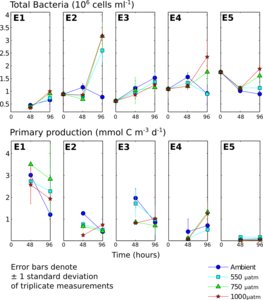OceanRep
Effect of enhanced pCO2 levels on the production of dissolved organic carbon and transparent exopolymer particles in short-term bioassay experiments.
MacGilchrist, G. A., Shi, T., Tyrrell, T., Richier, S., Moore, C. M., Dumousseaud, C. and Achterberg, Eric P.  (2014)
Effect of enhanced pCO2 levels on the production of dissolved organic carbon and transparent exopolymer particles in short-term bioassay experiments.
(2014)
Effect of enhanced pCO2 levels on the production of dissolved organic carbon and transparent exopolymer particles in short-term bioassay experiments.
![]() Biogeosciences (BG), 11
(13).
pp. 3695-3706.
DOI 10.5194/bg-11-3695-2014.
Biogeosciences (BG), 11
(13).
pp. 3695-3706.
DOI 10.5194/bg-11-3695-2014.
Preview |
Text
bg-11-3695-2014.pdf - Published Version Available under License Creative Commons Attribution. Download (989kB) | Preview |
![[thumbnail of suppfig_bactpp.svg.png]](https://oceanrep.geomar.de/25469/2.hassmallThumbnailVersion/suppfig_bactpp.svg.png)  Preview |
Image
suppfig_bactpp.svg.png - Supplemental Material Available under License Creative Commons Attribution. Download (141kB) | Preview |
Preview |
Text
Suppfig1 caption.pdf - Supplemental Material Available under License Creative Commons Attribution. Download (8kB) | Preview |
Preview |
Text
supplement-cover-letter.pdf - Supplemental Material Available under License Creative Commons Attribution. Download (18kB) | Preview |
Abstract
It has been proposed that increasing levels of pCO(2) in the surface ocean will lead to more partitioning of the organic carbon fixed by marine primary production into the dissolved rather than the particulate fraction. This process may result in enhanced accumulation of dissolved organic carbon (DOC) in the surface ocean and/or concurrent accumulation of transparent exopolymer particles (TEPs), with important implications for the functioning of the marine carbon cycle. We investigated this in shipboard bioassay experiments that considered the effect of four different pCO(2) scenarios (ambient, 550, 750 and 1000 mu atm) on unamended natural phytoplankton communities from a range of locations in the northwest European shelf seas. The environmental settings, in terms of nutrient availability, phytoplankton community structure and growth conditions, varied considerably between locations. We did not observe any strong or consistent effect of pCO(2) on DOC production. There was a significant but highly variable effect of pCO(2) on the production of TEPs. In three of the five experiments, variation of TEP production between pCO(2) treatments was caused by the effect of pCO(2) on phytoplankton growth rather than a direct effect on TEP production. In one of the five experiments, there was evidence of enhanced TEP production at high pCO(2) (twice as much production over the 96 h incubation period in the 750 mu atm treatment compared with the ambient treatment) independent of indirect effects, as hypothesised by previous studies. Our results suggest that the environmental setting of experiments (community structure, nutrient availability and occurrence of phytoplankton growth) is a key factor determining the TEP response to pCO(2) perturbations.
| Document Type: | Article |
|---|---|
| Additional Information: | WOS:000339265800016 |
| Keywords: | RSS Discovery ; D366 |
| Research affiliation: | OceanRep > GEOMAR > FB2 Marine Biogeochemistry > FB2-CH Chemical Oceanography OceanRep > GEOMAR > FB2 Marine Biogeochemistry > FB2-CH Chemical Oceanography > FB2-CH Water column biogeochemistry |
| Refereed: | Yes |
| Open Access Journal?: | Yes |
| Publisher: | Copernicus Publications (EGU) |
| Projects: | Future Ocean |
| Date Deposited: | 19 Aug 2014 09:41 |
| Last Modified: | 23 Apr 2021 08:37 |
| URI: | https://oceanrep.geomar.de/id/eprint/25469 |
Actions (login required)
 |
View Item |
Copyright 2023 | GEOMAR Helmholtz-Zentrum für Ozeanforschung Kiel | All rights reserved
Questions, comments and suggestions regarding the GEOMAR repository are welcomed
at bibliotheksleitung@geomar.de !


 Tools
Tools Tools
Tools
